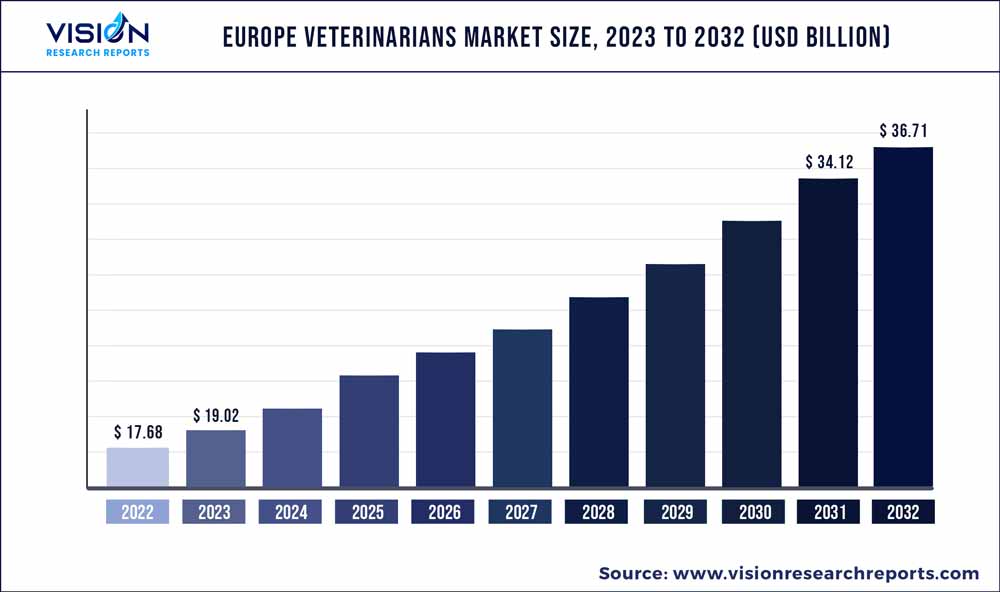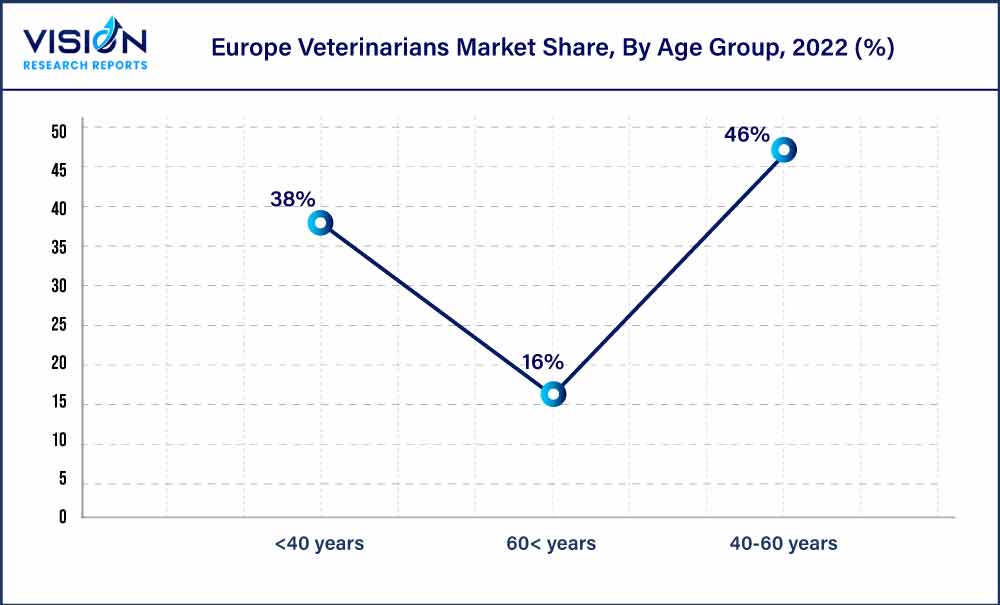The Europe veterinarians market was valued at USD 17.68 billion in 2022 and it is predicted to surpass around USD 36.71 billion by 2032 with a CAGR of 7.58% from 2023 to 2032.

Key Pointers
Report Scope of the Europe Veterinarians Market
| Report Coverage | Details |
| Market Size in 2022 | USD 17.68 billion |
| Revenue Forecast by 2032 | USD 36.71 billion |
| Growth rate from 2023 to 2032 | CAGR of 7.58% |
| Base Year | 2022 |
| Forecast Period | 2023 to 2032 |
| Market Analysis (Terms Used) | Value (US$ Million/Billion) or (Volume/Units) |
| Companies Covered | Zoetis Animal Healthcare, Boehringer Ingelheim, Ceva, Elanco, and Vetoquinol, among others |
Increasing demand for veterinary specialists, uptake of veterinary services, corporatization of veterinary practices, humanization of pets, and pet expenditure are some of the key factors propelling the market growth. In February 2023, for instance, the veterinary practice of Dr. Paulus in Saarbrücken, Germany, was merged into IVC Evidensia DACH Group. Similarly, in November 2022, the small animal practice of Dr. Angela Schulenburg and Dr. Guido Spitz in Eutin, Germany, was merged into the IVC Evidensia DACH Group.The growing employment opportunities are a key factor fueling the market. Veterinarians can work in private veterinary practices.
The COVID-19 pandemic adversely impacted the market with limited access, the closure of clinics, and a fall in demand.Some practices experienced a decline in revenue due to reduced patient visits and canceled elective procedures.Veterinarians faced increased stress and emotional challenges during the pandemic. The demands of working in a healthcare setting, managing client expectations, and coping with uncertainties took a toll on the mental health and well-being of veterinary professionals. Veterinary education also faced disruptions during the pandemic as institutions had to adapt to remote learning and virtual teaching methods, impacting hands-on practical training. The market, however, recovered gradually during 2021 as the underlying drivers remained unchanged.
The increasing demand for veterinarians with specialization and advanced skills is a key market driver. There is an increasing need for veterinarians with specialized skills and expertise in areas, such as orthopedics, cardiology, oncology, dentistry, and exotic animal medicine. Veterinary medicine has also witnessed significant advancements in diagnostic tools, treatment options, and surgical techniques. Veterinarians can pursue postgraduate studies or participate in continuing education programs to acquire these specialized skills. Vimian - a key European animal health company, hosts education and training for veterinary professionals to enable professional development, increase the quality of care, and drive sales & market growth.
Over 11,000 veterinary professionals participated in one or several of the company’s training in 2022.Technological advancements are also propelling the demand for veterinary professionals and their services. Digital record-keeping systems, telemedicine, remote monitoring devices, and advanced imaging techniques have improved the efficiency and effectiveness of veterinary services. Veterinarians are increasingly adopting these tools to increase their service offerings and client base. In 2022, Pets at Home-a UK-based pet care company reported a total of over 95,000 remote consultations conducted every year via its telehealth business. It also reported an increasing uptake of veterinary telehealth, triage, and ancillary services.
Sector Insights
The private sector segment dominated the market with a share of over 51% in 2022. This is owing to increasing corporatization across the region and the creation of larger practice groups that employ a significant number of veterinary professionals.Pets at Home Plc, for example, owns about 388 First Opinion small animal veterinary practices across the UK in conjunction with its Joint Venture Partners. It also operates 55 First Opinion practices that are company owned and managed.AniCura is another group that represents a family of 450 animal hospitals and clinics in Europe that employ about 4,000 veterinarians.
IVC Evidensia, on the other hand, is a leading provider of veterinary services in Europe. It operates via its network of over 2,500 clinics and hospitals that employ more than 41,000 veterinarians, referral specialists, nurses, and support staff. The others segment is projected to grow at the fastest CAGR of about 8% over the forecast years. It comprises veterinarians working in the academic sector, industry research, etc. In January 2022, the Royal Veterinary College in the UK partnered with the University of Pennsylvania’s School of Veterinary Medicine and MARS Equestrian to launch a scholarship program for equine health research. Similar supportive initiatives are expected to contribute to the segment's growth.
Age Group Insights
In terms of age group, the 40-60 years segment accounted for the largest share of over 46% of the market in 2022. The <40 years segment, on the other hand, is anticipated to grow at the highest rate of over 8% during the forecast period. As per a 2019 study published in the Irish Veterinary Journal in 2022, veterinarians in the age group of 40-60 years were found to be the largest number of registered veterinary practitioners with the Veterinary Council of Ireland. About 15.5% of registered veterinary practitioners were born in the 1960s, about 22% were born in the 1970s, and an estimated 26% were born in the 1980s.

There is a general trend of a relatively young veterinary workforce across the Europe region. Many veterinary professionals are in the early to mid stages of their careers. The number of veterinary graduates has been on the rise in recent years. Veterinary schools across Europe have been producing a larger number of graduates to meet the growing demand for veterinary services. This influx of new graduates has contributed to a younger veterinary workforce. Veterinary education programs too have evolved to align with the changing needs of the profession.
Animal Type Insights
By animal type, the companion animals segment held the largest share of the total market in 2022 while the livestock segment is projected to grow at the fastest rate of about 8.05% over the forecast years. This is owing to factors, such as increasing pet population, expenditure, pet humanization, consumption of meat & dairy products, and awareness about animal health. The rising pet ownership, expenditure, & humanization of pets leads to a higher demand for veterinary services, and thus veterinary professionals. Furthermore, aging pets require more specialized care, leading to an increased demand for veterinarians experienced in managing age-related health issues. European countries also have strict regulations in place to ensure the safety and well-being of animals used in food production.
Veterinary professionals play a crucial role in ensuring compliance with these regulations, conducting inspections, and monitoring animal health in livestock farming. The enforcement of these regulations drives the demand for veterinarians in the food industry. The One Health concept recognizes the interconnectedness of human health, animal health, and the environment. This approach highlights the need for collaboration between human health professionals and veterinarians to address zoonotic diseases and other health issues. The growing recognition of the One Health approach leads to an increased demand for veterinarians working in public health, research, and disease control.
Europe Veterinarians Market Segmentations:
By Sector
By Age Group
By Animal Type
Chapter 1. Introduction
1.1. Research Objective
1.2. Scope of the Study
1.3. Definition
Chapter 2. Research Methodology
2.1. Research Approach
2.2. Data Sources
2.3. Assumptions & Limitations
Chapter 3. Executive Summary
3.1. Market Snapshot
Chapter 4. Market Variables and Scope
4.1. Introduction
4.2. Market Classification and Scope
4.3. Industry Value Chain Analysis
4.3.1. Raw Material Procurement Analysis
4.3.2. Sales and Distribution Sector Analysis
4.3.3. Downstream Buyer Analysis
Chapter 5. COVID 19 Impact on Europe Veterinarians Market
5.1. COVID-19 Landscape: Europe Veterinarians Industry Impact
5.2. COVID 19 - Impact Assessment for the Industry
5.3. COVID 19 Impact: Major Government Policy
5.4. Market Trends and Opportunities in the COVID-19 Landscape
Chapter 6. Market Dynamics Analysis and Trends
6.1. Market Dynamics
6.1.1. Market Drivers
6.1.2. Market Restraints
6.1.3. Market Opportunities
6.2. Porter’s Five Forces Analysis
6.2.1. Bargaining power of suppliers
6.2.2. Bargaining power of buyers
6.2.3. Threat of substitute
6.2.4. Threat of new entrants
6.2.5. Degree of competition
Chapter 7. Competitive Landscape
7.1.1. Company Market Share/Positioning Analysis
7.1.2. Key Strategies Adopted by Players
7.1.3. Vendor Landscape
7.1.3.1. List of Suppliers
7.1.3.2. List of Buyers
Chapter 8. Europe Veterinarians Market, By Sector
8.1. Europe Veterinarians Market, by Sector, 2023-2032
8.1.1 Private
8.1.1.1. Market Revenue and Forecast (2020-2032)
8.1.2. Public
8.1.2.1. Market Revenue and Forecast (2020-2032)
8.1.3. Others
8.1.3.1. Market Revenue and Forecast (2020-2032)
Chapter 9. Europe Veterinarians Market, By Age Group
9.1. Europe Veterinarians Market, by Age Group, 2023-2032
9.1.1. <40 years
9.1.1.1. Market Revenue and Forecast (2020-2032)
9.1.2. 40-60 years
9.1.2.1. Market Revenue and Forecast (2020-2032)
9.1.3. 60< years
9.1.3.1. Market Revenue and Forecast (2020-2032)
Chapter 10. Europe Veterinarians Market, By Animal Type
10.1. Europe Veterinarians Market, by Animal Type, 2023-2032
10.1.1. Companion Animals
10.1.1.1. Market Revenue and Forecast (2020-2032)
10.1.2. Livestock Animals
10.1.2.1. Market Revenue and Forecast (2020-2032)
Chapter 11. Europe Veterinarians Market, Regional Estimates and Trend Forecast
11.1. Europe
11.1.1. Market Revenue and Forecast, by Sector (2020-2032)
11.1.2. Market Revenue and Forecast, by Age Group (2020-2032)
11.1.3. Market Revenue and Forecast, by Animal Type (2020-2032)
Chapter 12. Company Profiles
12.1. Zoetis Animal Healthcare
12.1.1. Company Overview
12.1.2. Product Offerings
12.1.3. Financial Performance
12.1.4. Recent Initiatives
12.2. Boehringer Ingelheim.
12.2.1. Company Overview
12.2.2. Product Offerings
12.2.3. Financial Performance
12.2.4. Recent Initiatives
12.3. Ceva
12.3.1. Company Overview
12.3.2. Product Offerings
12.3.3. Financial Performance
12.3.4. Recent Initiatives
12.4. Elanco.
12.4.1. Company Overview
12.4.2. Product Offerings
12.4.3. Financial Performance
12.4.4. Recent Initiatives
12.5. Vetoquinol
12.5.1. Company Overview
12.5.2. Product Offerings
12.5.3. Financial Performance
12.5.4. Recent Initiatives
Chapter 13. Research Methodology
13.1. Primary Research
13.2. Secondary Research
13.3. Assumptions
Chapter 14. Appendix
14.1. About Us
14.2. Glossary of Terms
 Cross-segment Market Size and Analysis for
Mentioned Segments
Cross-segment Market Size and Analysis for
Mentioned Segments
 Additional Company Profiles (Upto 5 With No Cost)
Additional Company Profiles (Upto 5 With No Cost)
 Additional Countries (Apart From Mentioned Countries)
Additional Countries (Apart From Mentioned Countries)
 Country/Region-specific Report
Country/Region-specific Report
 Go To Market Strategy
Go To Market Strategy
 Region Specific Market Dynamics
Region Specific Market Dynamics Region Level Market Share
Region Level Market Share Import Export Analysis
Import Export Analysis Production Analysis
Production Analysis Others
Others